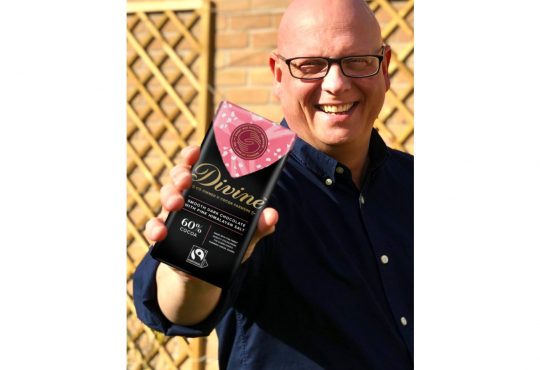
Joana Groba Casillas, 23, has just completed her masters’ degree at Chelsea college of Art and Design, displaying a piece titled Identitatis at the postgraduate summer show. As migrants attempt to find safety away from the current warzone in Syria, it has touched the hearts of many, and inspired Joana to show the other side of the ocean. Born in Columbia but residing in Madrid throughout most of her life, it is a passionate topic for her. She tells Chelsea Monthly all about her recent exhibition, the inspirations for it and what’s next for her conceptual work.
Can you tell us a bit more about your piece?
The piece that I did was for the MA fine art show at Chelsea. It’s an installation, which has two pieces, a video and a mural. It’s adapted to a specific space of 5mx5m and one of the walls has a mirror vinyl attached. The projection of the sea is projected into that mirror and reflected back into a mural made out of concrete.
How did you come up with that idea?
It’s a whole year investigation; I started researching about identity and origins of ethnicity. And I ended up with the concept of migration and identity on the migration. Especially with the whole situation in Spain and the south of Europe with migration and the constant cases of people travelling and passing away trying to cross the ocean. Because I live in Spain, I go to the coast quite often. I guess the concept of the sea is quite different and I was able to interview someone that was in contact with that situation. His concept of the sea was completely different; he would say that the sea was a graveyard and because he was there helping people get out of boats, I guess that was strong imagery. Most people don’t see that, they see a relaxing environment, peaceful even. When it actually doesn’t completely reflect that.
You can tell that a lot of thought has gone into your piece; you even incorporated the seawater that contains the DNA of deceased migrants?
I mixed the water of the Mediterranean with the cement, so the actual cement would contain that water and it would be concrete. The sea that is projected is also the sea of the Mediterranean.
How did the exhibition go?
I think it went pretty well, the preview on the first night was pretty full. I think that was the worst night for people to actually see work because there were too many people. But I had really good feedback, even to the last day there were quite a lot of people coming through.
So, this piece has taken you a year to complete along with the idea?
This concept was a bit more recent because I had been exploring more of the concept of ethnicity and classification.
Have you come across any struggles with this exhibition?
Oh, yes! First of all the size. This was the first time I’d actually used concrete. I had serveral problems with the ratio of water and because its sea water I guess the hardness varies, so you have to do several trials. And then once you do there’s the weight, to move it around and find a wall that’s strong enough for it to lean over.
Are there any artists that inspired this idea?
It’s not so much the idea, but the way of portraying all of this, its conceptual rather than literal. For Adrian Piper, Santiago Sierra and Dora Garcia, its more about the concept than the actual idea, I guess any artist that works in this way was a big inspiration.
What’s been your favourite piece that you’ve worked on?
I have several different lines of work; this is all about identity and origins. And I did several urban interventions for Space, public space and the concept of exclusion, where I take ground and reconfigure pathways. That was fun because you get to see the reactions of people when they avoid or play around with those marks in the ground.
Are you working on anything right now?
I quite interested in continuing working with the cement. But its not like I follow a pattern, my pieces don’t have similarities in the materials from one piece to another, it’s more about the concept that actually flows.
Do you have any more exhibitions aligned for the coming months?
Well right now I’m looking forward to moving back to London mid October time. I’m staying with a couple of MA students to curate a show outside of Chelsea, but that would be around November time. But yeah any show that comes up really. We’re also working with Chelsea salon.
Where do you see yourself in 5 years time?
I would want to project myself, seeing myself working in Madrid, well not working but establishing Madrid by producing more for either London or New York. I would probably like to be associated with a particular gallery and push myself like Oscar Murillo did.
Is Oscar Murillo someone that you look up to?
Yeah, he’s a young Columbian artist, that made smart choices enabling him to become well recognised. He was selected by one of the most influential curators at the moment, Okwui Enwezor for the Venice Biennale 2015.
What enticed you to come over to London for your postgraduate degree?
There is more opportunity for showing work and exhibiting, but also its more open to a younger market. It’s a big city, which is constantly alive. The vibe pushed me to want to go to London.
Have you received any negative feedback that may have deterred your ambitions?
With my work they usually don’t tell you. Someone recently said it was too conceptual. But art is changing a lot, it’s diverting into that art that is commercial and conceptual. The work that is shown for the experience of watching or seeing, whereas others are made to observe as it’s hanging in your living room.
What made you want to study art? Has it always been a passion?
Yeah, there was never a moment I doubted that this was what I wanted.
Do you have any advice for other budding artists?
Apply to everything you can, every contest, every residency, everything you can. most importantly always be honest with everything you do!










